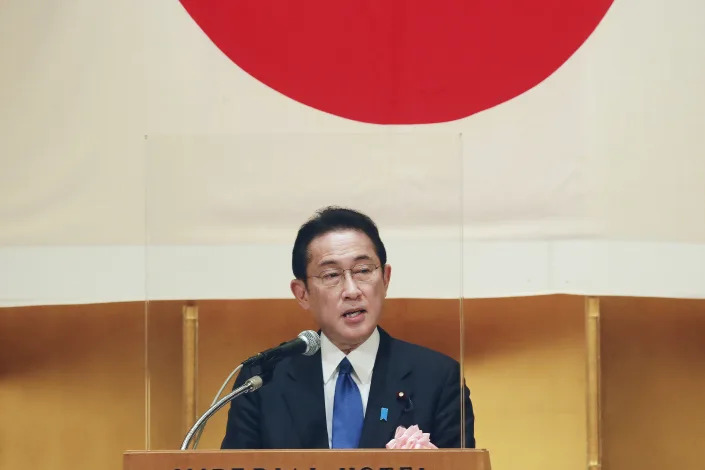
FILE - Japanese Prime Minister Fumio Kishida delivers a speech during a New Year celebration party of business leaders in Tokyo, Wednesday, Jan. 5, 2022. Kishida said Friday, Jan. 28, 2022, that Japan will recommend a former gold mine on Sado Island for a UNESCO World Heritage list, despite protests from South Korea that the site is inappropriate because of its wartime abuse of Korean laborers — a sensitive issue that still strains ties between the neighbors.
(AP Photo/Koji Sasahara, File)
MARI YAMAGUCHI
Fri, January 28, 2022
TOKYO (AP) — Prime Minister Fumio Kishida said Friday that Japan will recommend a former gold mine on Sado Island for a UNESCO World Heritage list, despite protests from South Korea that the site is inappropriate because of its wartime abuse of Korean laborers — a sensitive issue that still strains ties between the neighbors.
Kishida's decision to nominate the 400-year-old site in northern Japan apparently reverses his earlier, more cautious stance after a strong push by powerful ultra-rightwing historical revisionists in his governing party.
Kishida said the Sado mine is valuable in Japan's industrial history.
“Despite its high value, I understand that there are various views about its registration ... That's why we want to start discussions early," he said.
The Sado mine was selected last month by Japan’s Council for Cultural Affairs as a candidate for a UNESCO World Heritage site, triggering South Korean protests.
Seoul opposes Japan’s nomination because many Koreans brought to Japan during its 1910-1945 colonization of the Korean Peninsula were put to forced labor at the mine.
South Korea’s Foreign Ministry expressed “strong regret” over the Japanese decision and urged Tokyo to stop the effort. Second Vice Minister Choi Jong-moon summoned Japanese Ambassador Koichi Aiboshi to lodge a protest over the issue.
Historians say Japan used hundreds of thousands of Korean laborers, including those forcibly brought from the Korean Peninsula, at mines and factories to make up for labor shortages, as most working-age men were sent to battlefronts across Asia and the Pacific.
The town and prefectural sites praise the Sado mine for demonstrating outstanding mining technology development before and after industrialization, once becoming the world’s largest gold producer before its closure in 1989. There is no mention of its wartime use of Korean laborers.
The Sado nomination recalls Japan's 2015 registration of the Gunkanjima, or Battleship Island, in Nagasaki, as part of UNESCO “Sites of Japan’s Meiji Industrial Revolution." South Korean protests about the site omitting mention that Koreans also toiled on the island triggered a UNESCO decision urging Japan to present a more balanced version of history.
South Korea's Foreign Ministry demanded Friday that Japan educate its people about Korean laborers abused during the Japanese colonial rule, a promise Tokyo made when Gunkanjima was registered.
Kishida said a “calm and thorough discussion” should be held over the planned registration of the Sado mine. Kishida said his Cabinet will formally approve the recommendation of Sado on Tuesday.
Kishida’s government previously considered delaying the nomination but apparently reversed itself after facing growing pressure from former Prime Minister Shinzo Abe and his supporters, who are known for their efforts to whitewash Japan’s wartime past.
“It is wrong to not recommend it by avoiding a war of words. We should fight back with facts,” Abe said last week at a meeting of his group within the ruling party. His protégé and party policy chief Sanae Takaichi told a parliamentary session this week that the issue is “a matter of Japan’s honor.”
Relations between Tokyo and Seoul are currently at their lowest level in years due to disputes stemming from Japan’s sexual abuse of Korean women and use of forced laborers before and during World War II.
The government is expected to submit a letter of recommendation to UNESCO by the Feb. 1 deadline.
If everything goes as planned, a UNESCO advisory group will survey the mine site in the fall before deciding around May 2023 whether to add it to the list ahead of the World Heritage Committee screening.
___
Associated Press writer Kim Tong-hyung in Seoul, South Korea, contributed to this report.
No comments:
Post a Comment